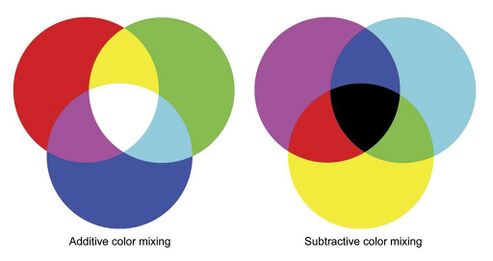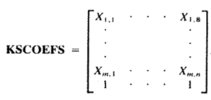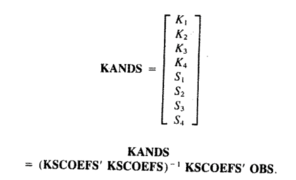
Color Mixing[edit | edit source]
In the field of color blending, there are three primary methods: Additive, Subtractive, and Average color mixing.
Additive color mixing occurs when light beams overlap, whereas Subtractive color mixing involves a light source and physical substances, such as dyes, which absorb specific light wavelengths while reflecting the rest, making them visible to the eye. For instance, with red pigment, all visible light wavelengths are absorbed except for the red portion, which we perceive as the color red.
Average Color Mixing[edit | edit source]
An example of Average color mixing is a rapidly spinning color wheel, where the average color is perceived with a brightness level equal to the average brightness of the mixed colors. The ability to predict the resulting color when mixing colors has always been a topic of interest. When you possess a model that can anticipate the outcome of color mixing, you can recreate a desired color by combining precise amounts of primary colors.
Additive Color Mixing[edit | edit source]
Additive color mixing is commonly employed in digital applications like displays, typically utilizing red, green, and blue as primary colors. Predicting the outcome of additive color mixing is conceptually simpler, as it involves combining lights with energy in different portions of the visible spectrum.
Subtractive Color Mixing[edit | edit source]
On the contrary, subtractive color mixing presents greater complexity and poses a more challenging prediction task. In subtractive mixing, our objective often revolves around uncovering the link between colorants, their concentrations, and the resultant color when combined. According to Berns (1997), it is possible to model various coloration systems through a two-step method. The initial step entails identifying a model in which the connection between components and spectral data follows a linear pattern. This linear relationship necessitates two key conditions. Firstly, scalability is essential, implying that the spectral data for each colorant should be scalable. Secondly, additivity plays a crucial role, where the prediction of a mixture relies on the summation of each colorant's contributions. Berns' second step involves establishing the relationship between user controls and the effective amount of colorants involved. [1]
Kubelka-Munk Theory[edit | edit source]
The Kubelka-Munk theory has been applied in the modeling of opaque paint combinations. Within this framework, the absorption and scattering characteristics of each colorant are utilized to construct a linear model. Specifically, the equation below illustrates the Two-constant Kubelka-Munk theory, which involves two separate scattering and absorption units for each color:

Where 𝑘𝜆, and 𝑠𝜆 are the absorption and scattering properties of a colorant at unit amount, and 𝑐𝑒,1 denotes specific amount of each colorant. Also, the transformation between the reflectance factor and the (𝐾/𝑆) 𝜆,𝑚𝑖𝑥𝑡𝑢𝑟𝑒 of each mixture is shown in equation below:

Through the combination of predetermined quantities of each colorant, measuring the resulting reflectance, and applying these equations, we can establish an initial basis for an optimization procedure aimed at determining the absorption and scattering coefficients for each colorant. Following this, it is advisable to create a gradient of color mixtures by varying the concentration ratios of each color and white colorants. [2] One way for doing the optimization is using the method of linear least squares, by having different combinations of each colorant and white substrate/colorant and forming independent linear equations for scattering and absorption property of each mixture. An example of this matrix equation is shown below:



Optimization[edit | edit source]
References[edit | edit source]
[1] Roy S Berns, “Billmeyer and Saltzman’s Principles of Color Technology, Fourth Edition”, Wiley Interscience Publication, 2019
[2] Roy S Berns, Mahnaz Mohammadi, “Evaluating single- and two- constant Kubelka-Munk Turbid Media Theory for Instrumental-based inpainting”, Studies in Conversion, Vol 52, 2007

